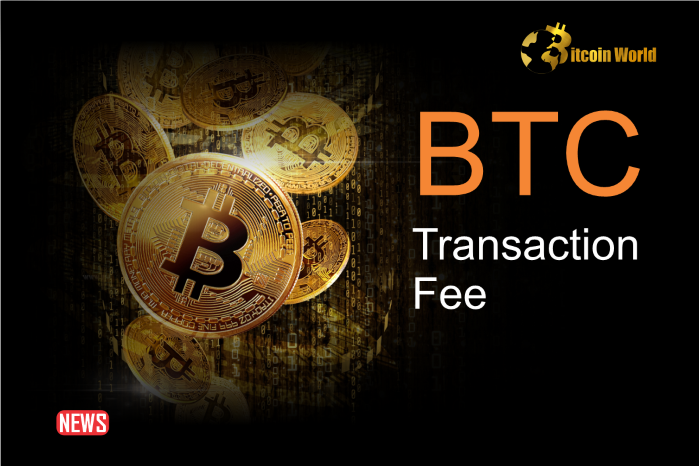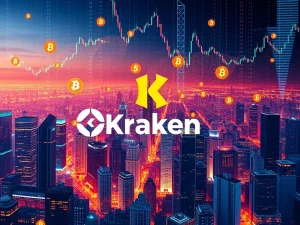Soaring Bitcoin transaction fee Hits 2024 High Amid Falling Network Activity

BitcoinWorld
Soaring Bitcoin transaction fee Hits 2024 High Amid Falling Network Activity
Bitcoin’s world is often full of fascinating paradoxes, and the latest data point is no exception. While you might expect transaction costs to decrease when fewer transactions are happening, we’re currently seeing the opposite trend. The average Bitcoin transaction fee has tapped its highest level so far this year, presenting an intriguing puzzle for users and observers alike.
What’s Happening with Bitcoin Transaction Fee?
According to data from The Block, the seven-day moving average (MA) for the Bitcoin transaction fee has climbed to $2.40. This represents a modest but significant increase of about 1% since the beginning of May and marks the highest point this metric has reached throughout 2024.
This increase in average fee comes at a time when the sheer number of transactions on the network is actually declining. The average number of BTC daily transactions has seen a notable drop of 35% in just over a month, falling from a peak of 507,000 on April 22 to the current figure of around 330,000.
Let’s look at the data points side-by-side:
Metric
April 22nd (Approx)
Current (Approx)
Change
7-day MA Transaction Fee
Lower than $2.40
$2.40 (Year High)
Increase (Approx 1% since early May)
Average Daily Transactions
507,000
330,000
35% Decrease
This divergence between rising average cost and falling volume is the core of the current situation.
The Puzzle: Rising BTC Fees Amid Falling Volume
Typically, in a simple supply-and-demand model for block space (where transactions compete to be included in the next block), lower transaction volume would imply less competition, leading to lower fees. The fact that BTC fees are rising despite a significant drop in the number of daily transactions suggests that other factors are at play.
Several potential reasons could explain this phenomenon:
Transaction Complexity: While the *number* of transactions is down, the *complexity* or *size* of the average transaction might have increased. Certain types of transactions, like those involving Ordinals or BRC-20 tokens, can be larger and consume more block space, potentially driving up the average fee even if there are fewer of them overall.
Specific High-Value Transactions: A concentration of high-value transactions that are willing to pay a premium fee could skew the average upwards, even if the bulk of transactions are paying less or waiting longer.
Network Congestion Spikes: Even with overall lower volume, temporary spikes in demand for block space at specific times could push fees higher, influencing the 7-day moving average.
Miner Strategy: Miners prioritize transactions based on the fee offered per unit of block space (sat/vB). If a smaller number of high-fee transactions are consistently available, miners will include those, potentially leaving lower-fee transactions pending and effectively raising the ‘clearing price’ for block space, thus increasing the average fee.
Understanding the nuances of the Bitcoin network activity is key to deciphering these trends.
Why Are Crypto Transaction Fees Behaving This Way?
The behavior of crypto transaction fees, particularly on a network like Bitcoin with limited block space, is a dynamic market. The fee paid is essentially a bid for inclusion in the next block. Miners, who secure the network by creating new blocks, earn rewards from two sources: the block subsidy (newly minted BTC) and the transaction fees within the block.
Following the recent Bitcoin halving event, the block subsidy was reduced. This shifts the balance, making transaction fees a relatively more important component of miner revenue. While it’s not a direct cause of *this specific* fee increase, the post-halving environment means miners are inherently more incentivized to prioritize transactions that offer higher fees per byte.
The rise in the average Bitcoin transaction fee could be a signal that even with fewer transactions overall, the competition for block space from certain types of transactions remains significant enough to keep fees elevated for those who need faster confirmation times.
Impact on Users and Bitcoin Network Activity
For the average user, rising crypto transaction fees can be a significant factor, especially for smaller transfers. Sending a small amount of BTC becomes less economically viable when the fee represents a large percentage of the transaction value. This can impact various types of Bitcoin network activity, including:
Micro-transactions: These become impractical.
Wallet Consolidation: Users might postpone consolidating small UTXOs (Unspent Transaction Outputs) due to cost.
Exchange Withdrawals: Exchange withdrawal fees are often influenced by network conditions.
However, it’s important to remember that $2.40, while the highest 7-day average this year, is still relatively low compared to historical peaks seen during periods of intense congestion or specific market crazes (like the height of the Ordinals boom in 2023, when average fees could soar into the tens or even hundreds of dollars). So, while elevated for 2024, the current fee level isn’t prohibitive for all types of transactions.
Navigating High BTC Daily Transactions Costs
If you need to make a Bitcoin transaction when fees are elevated, here are some actionable insights:
Check Current Fees: Use reliable mempool visualizers or fee estimator websites (like mempool.space or marketplaces like BitInfoCharts) to see the current state of network congestion and recommended fees for different confirmation speeds.
Be Patient (If Possible): If your transaction isn’t time-sensitive, you can often set a lower fee and wait longer for it to be confirmed. Wallets usually allow you to set custom fees or choose between priority/economic options. Be aware that setting too low a fee might result in your transaction being stuck for a long time.
Use SegWit or Taproot Addresses: Ensure your wallet uses modern address formats (starting with ‘bc1’). These transaction types are generally more efficient in terms of block space usage, which can translate to slightly lower fees compared to older formats (starting with ‘1’ or ‘3’).
Consider Off-Chain Solutions: For frequent, small transactions, explore off-chain solutions like the Lightning Network, which offers near-instant, very low-cost transfers.
While the drop in the number of BTC daily transactions might suggest a decrease in overall usage, the rising average fee indicates that the demand for block space from certain types of transactions remains robust, creating this counter-intuitive market condition.
Conclusion
The current state of the Bitcoin network, where the 7-day moving average transaction fee is hitting a yearly high while the average number of daily transactions declines, highlights the complex dynamics of the fee market. It suggests that factors beyond simple transaction count, such as transaction type and size, are significantly influencing costs. For users, staying informed about current network conditions and utilizing fee management strategies is crucial. For the network and miners, this trend underscores the evolving importance of transaction fees in the post-halving era and the ongoing competition for limited block space.
To learn more about the latest Bitcoin market trends, explore our articles on key developments shaping Bitcoin price action and network activity.
This post Soaring Bitcoin transaction fee Hits 2024 High Amid Falling Network Activity first appeared on BitcoinWorld and is written by Editorial Team










